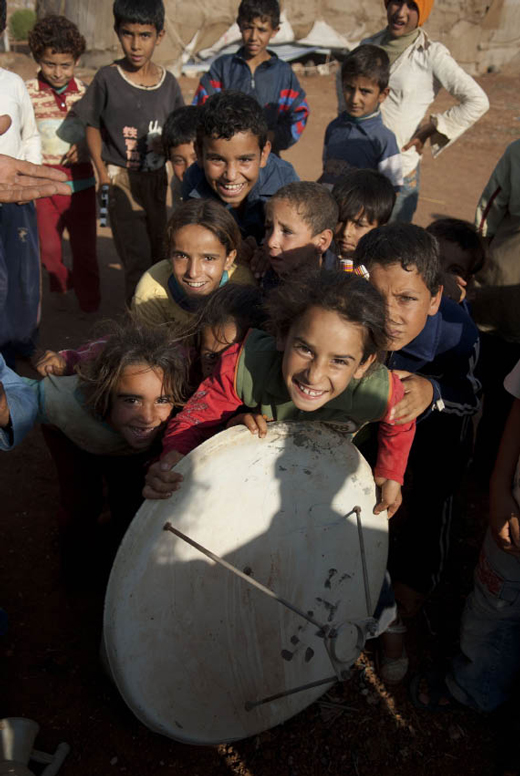There is a growing global demand for organic products. So why are Syrian farmers who grow their food organically not bothering to register it as such?
Hundreds of olive trees dot the road to Ahmad al-Masalmeh’s organic farm in the Dera’a governorate south of Damascus, forming a thick, green barrier. With its beautiful swimming pool and friendly dogs, Masalmeh’s property looks more like a summer house than a farm producing organic olives and grapes. Masalmeh proudly shows off his estate to visitors and explains in detail how each of the different insect traps dangling from his prized olive trees work to keep the bugs away.
“I worked with expatriate engineers and investors and they introduced the concept of organic farming to me,” Masalmeh, an agriculture engineer who first learned about organic farming in 1985, said. “It seemed well worth it. No need for expensive chemical fertilizers and pesticides. It’s enough to make organic insect traps and raise farm animals to use their compost as fertilizers. Organic farming seemed a healthy, cheap and profitable endeavour.”
Masalmeh contacted an organic farming certification body located outside Syria – the country does not have such an institution – and applied for accreditation. The process was not as straightforward as he thought. Inspectors visited the farm to test the soil and water. Annual inspections, sometimes surprise ones, followed to ensure that Masalmeh’s produce was free of chemicals.
“Organic farming isn’t only about not using chemicals,” he said. “I had to prove that the area where my farm is located isn’t polluted, gather the crops manually, squeeze them on the same day and have all this documented.”
The accreditation process was far from cheap. With Syria lacking an organic certification body, farmers who wish to acquire the label have to obtain it through an international body. In addition to the high registration fees, they must pay the full cost of an inspector’s trip. While the price of accreditation varies according to the size of the farm, for Masalmeh’s 500-square-metre property, the entire process cost him around SYP 500,000 (USD 10,638).
Few Syrian farmers can afford such an outlay. As a result, most local farmers abiding by organic principles do not apply for accreditation. Rather, they sell their produce as regular, non-organic food.
“Although organic products are cheaper to produce and can be sold for higher prices than non-organic ones, the high cost of accreditation makes it more profitable to sell it as non-organic,” Masalmeh, who only applied for accreditation in 2002 after 17 years of organic farming, said.
Increases in the prices of diesel and natural fertilizer over the past two years have also taken a financial toll on Masalmeh, so much so that this year he could not afford to renew his accreditation.
“I grow organic grapes, but I didn’t apply for accreditation,” he said. “It’s only worth it if I can export my production. But with the intense competition in the Syrian market and with the small-scale production I have, this is close to impossible.”
Cotton is key
Syria’s chief organic crop is cotton. Indeed, Syria was the world’s third-largest producer of organic cotton last year, according to industry research house Organic Exchange. According to Souhel Makhoul, director of the Horticulture Research Administration at the General Commission for Scientific Agricultural Research (GCSAR), organic cotton was produced on only 373 hectares just five years ago, but that has increased to around 28,000 hectares.
A growing number of Syrian textile companies are also moving to make use of this local, green resource. These include Bawdiqji Company in Aleppo and the Cotton Spinning Company and Manaa Brothers Company in Hama. According to a recent report by Syria’s state-owned news agency SANA, the country will soon export its first batch of clothes manufactured from organic cotton. While the EU looms as the primary market, shipments will also go to China and Mexico.
Syria also produces organic olive oil, laurel soap, medical herbs and grapes which are generally exported to the EU. Compiling an accurate picture of these organic exports is all but an impossible task, however, as organic products have not been issued with a separate customs number and as such are simply recorded as agricultural exports.
Planting the seed
Interest in organic products is spiking throughout the world, particularly in industrialised economies. Globally, organic food sales have jumped from SYP 47bn (USD 1bn) in 1990 to SYP 2.44trn (USD 52bn) in 2008, according to figures from the international research house Datamonitor. Market research also shows that organic foods represent one of the fastest-growing food segments in the EU and US. Syria, however, still lacks a dedicated local market.
“When convincing local farmers to go organic, the first thing they ask is: “Where are we going to sell our products?'” Makhoul said. “Unfortunately, there’s no local market for organic products as few Syrians are aware of their importance.”
This is, however, slowly changing. Market research carried out in Damascus, Aleppo, Homs and Lattakia by the GCSAR, in collaboration with the UN’s Food and Agriculture Organization (FAO) in Damascus, found that growing numbers of Syrians are willing to pay more to eat organic. And while still few, foreign organic products can be found in some malls in major cities. Yet despite growing interest in ‘green food’, Makhoul said that, at the moment, the only profitable market for local organic products is a foreign one.
The Institutional Development of Organic Agriculture in Syria (IDOAS), a four-year initiative between the GCSAR, the Ministry of Agriculture and Agrarian Reform and FAO, was set up in 2006 to develop the organic sector. The initiative was tasked with developing legal, institutional and scientific platforms for organic agriculture in the country. Its main achievement to date has been drafting a law to govern and promote organic agriculture which is presently awaiting approval from Syria’s parliament.
“The law will regulate organic farming in Syria so that it adheres to international standards,” Mohammad al-Abdallah, director of agricultural counselling at the Ministry of Agriculture and Agrarian Reform, said. “It will also regulate the relationship between the farmer and the certification body. Today, farmers contact the companies individually, but after issuing the law, companies will have to get permission to work inside Syria.”
Early this year, the second part of the IDOAS initiative started. It aims to establish a dedicated organic department in the Ministry of Agriculture and Agrarian Reform. The initiative will also continue to carry out several capacity-building workshops to encourage farmers to go organic. Eggs, dairy, fruits, cereals, grains and vegetables are all potential areas of organic expansion. The IDOAS is also compiling market research on potential local, regional and international markets.
“Syria has potential for organic farming because of its weather and because Syrian farmers prefer natural insect traps to pesticides, many of which are available locally,” Makhoul said. “Furthermore, there are many virgin fields in Syria that could be easily converted to organic fields and many products, like olive oil for example, that don’t require pesticides. In fact, the ministry is already using chemical-free pesticides in citrus, cotton and vegetables.”
Masalmeh, the organic farmer from Dera’a, said that without serious government support, organic farming in Syria is doomed to remain an individual and costly endeavour. At present, local organic fruit and vegetable producers lack the economies of scale or experience to tap into lucrative foreign markets.
“It’s hard to make a profit out of organic farming,” Masalmeh said. “We need a non-profit organic farmers’ association and a fund for organic agriculture that would cover the accreditation costs or the establishment of a local certifying body.”
This article was published in Syria Today magazine.Issue no. 64




